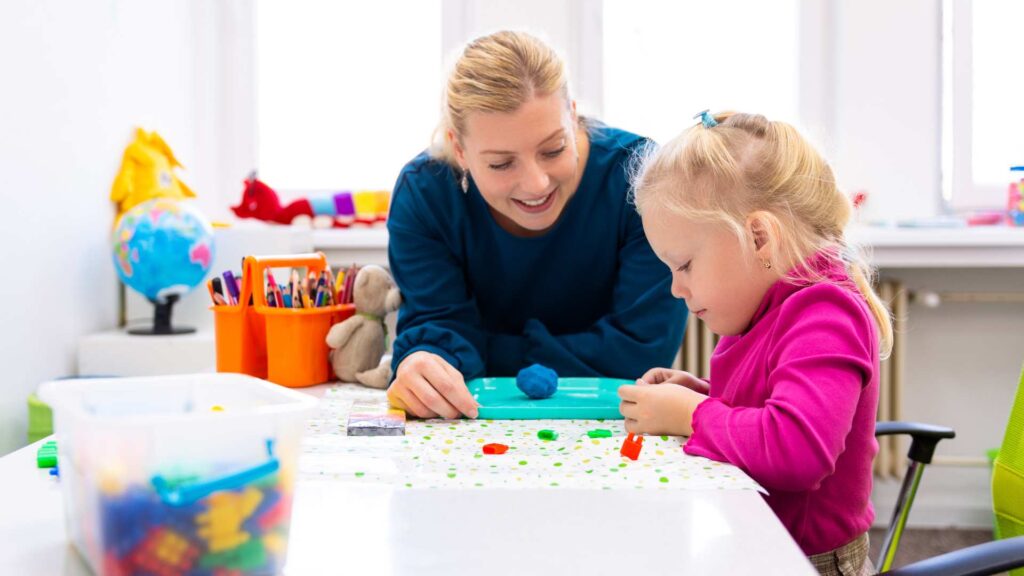Table of Contents
What are examples of repetitive behavior in autism?
Some behaviors can be natural and experienced by anyone at some point, but they can also be indicative of a deeper issue within certain conditions. For example, repetitive behaviors in autism are common. While many people might engage in similar behaviors occasionally to cope with stress or anxiety, for individuals with autism spectrum disorder (ASD), these behaviors often serve a more significant purpose related to their condition.
But what exactly do these repetitive behaviors look like? You may have seen a child flapping their hands, rocking back and forth, or repeating phrases. These actions, often called self-stimulatory behaviors or “stimming,” are actually a core feature of autism spectrum disorder (ASD) and are even part of the diagnostic criteria in the DSM-5.
In this blog, ABA Centers of New Jersey will explore why repetitive behaviors occur in autism, whether they require intervention when they might become problematic, and how ABA therapy can help—without being intrusive or restrictive.
Why Do Repetitive Behaviors Occur in Autism?

Repetitive behaviors in autism are one of the core characteristics of the condition, as outlined in the DSM-5. These behaviors can range from simple movements like hand-flapping to more complex routines or rituals that a child feels compelled to follow.
But why do they happen? According to the American Psychiatric Association, stimming, or repetitive behaviors in autism, serves various purposes, such as reducing anxiety, managing sensory overload, expressing emotions, or relieving discomfort.
Research by Sage Journals explored the experiences of 32 autistic adults, revealing that stimming is primarily a self-regulation tool rather than just a symptom of autism. Many participants opposed efforts to eliminate these behaviors, emphasizing their role in coping with intense emotions.
Moreover, Development and Psychopathology examined whether these behaviors stem from attention difficulties, motor impairments, or both. They tested 22 adolescents with ASD and 20 typically developing peers using tasks that measured attention and motor skills. The results showed that difficulties in directing attention (attentional orienting) and motor control are linked, suggesting they arise from the same underlying issue.
Examples of Repetitive Behaviors in Autism
Repetitive behaviors in autism can manifest in various ways, from physical movements to rigid thought patterns, according to the Journal of Child Psychology. These behaviors generally fall into two categories:
1. Self-Stimulatory Behaviors
Stimming is perhaps the most well-known form of repetitive behavior in autism. It includes actions that stimulate the senses, such as:
- Hand-flapping
- Rocking back and forth
- Spinning in circles
- Flicking fingers or tapping surfaces
- Repeating words or phrases (echolalia)
- Fixating on specific sounds or lights
While stimming can help with emotional regulation, it may sometimes interfere with learning or social interactions, making it necessary to find alternative coping strategies.
2. Rigid Routines and Rituals
Many individuals with autism develop strict routines that they feel compelled to follow. Examples include:
- Needing to take the same route every day
- Arranging objects in a precise order
- Insisting on eating the same foods repeatedly
- Experiencing distress when routines are disrupted
These behaviors provide predictability in a world that may feel chaotic, but when they become too rigid, they can limit flexibility and adaptation to new experiences.
Should Parents Try to Stop Repetitive Behaviors?
A common question among parents is whether they should intervene to stop repetitive behaviors. The answer depends on context. Some repetitive behaviors in autism are harmless and even beneficial, helping children regulate emotions or focus. However, others may become problematic if they:
- Interfere with daily activities or learning
- Cause physical harm (e.g., head-banging or excessive scratching)
- Lead to social isolation or difficulties in forming relationships
In cases where repetitive behavior becomes disruptive and challenging, the goal isn’t necessarily to eliminate it but to redirect it into a more functional alternative. For instance, if a child bites their hand when anxious, a therapist may introduce a safe sensory tool, like a chewable necklace, to fulfill the same need in a less harmful way.
When Do Repetitive Behaviors Become a Concern?
Repetitive behaviors are not inherently harmful. However, parents should consider intervention when these behaviors:
Limit social interactions: If a child is so engaged in repetitive actions that they struggle to participate in group activities or conversations.
Impact learning: If a behavior prevents them from focusing on new skills or completing daily tasks.
Pose safety risks: If a child engages in self-injurious behaviors like head-hitting or excessive skin-picking.
Understanding the purpose of the behavior is crucial before deciding on any intervention. Instead of suppressing it outright, as previously said, professionals should focus on providing healthier alternatives.
How ABA Therapy Supports Children on the Spectrum with Repetitive Behaviors

Applied Behavior Analysis (ABA) therapy is one of the most researched and practical approaches for addressing repetitive behaviors in autism. However, a common concern among parents is whether ABA is too restrictive or forces children to conform unnaturally.
The reality is that ABA therapy does not aim to suppress behaviors simply for the sake of making a child appear more “typical.” Instead, ABA focuses on understanding the function of the behavior, such as why the child is engaging in it, encouraging alternative strategies that serve the same purpose but are more functional and not harmful, and reinforcing positive behaviors without being forceful or intrusive.
For example, if a child engages in excessive hand-flapping when anxious, an ABA therapist might introduce deep-breathing exercises, fidget toys, or structured breaks as alternative coping strategies. The goal is not to erase stimming but to ensure the child can engage with the world comfortably and effectively!
How ABA Therapy Supports Children with Repetitive Behaviors
At ABA Centers of New Jersey, we know that every child is unique; that’s why we craft tailored ABA therapy programs depending on the goals and needs of the kid and teen on the spectrum and the family.
Instead of using a one-size-fits-all model, our approach focuses on helping children develop communication and daily living skills, supporting parents with practical strategies for home and school life, and encouraging positive skills and growth without suppressing natural expressions.
Whether your child engages in repetitive behaviors that require guidance or you need additional support in their development, we’re here to help! Call us at (855) 640-7888 or schedule a free consultation with one of our autism experts to learn how our services can empower your child while honoring their unique way of experiencing the world.








